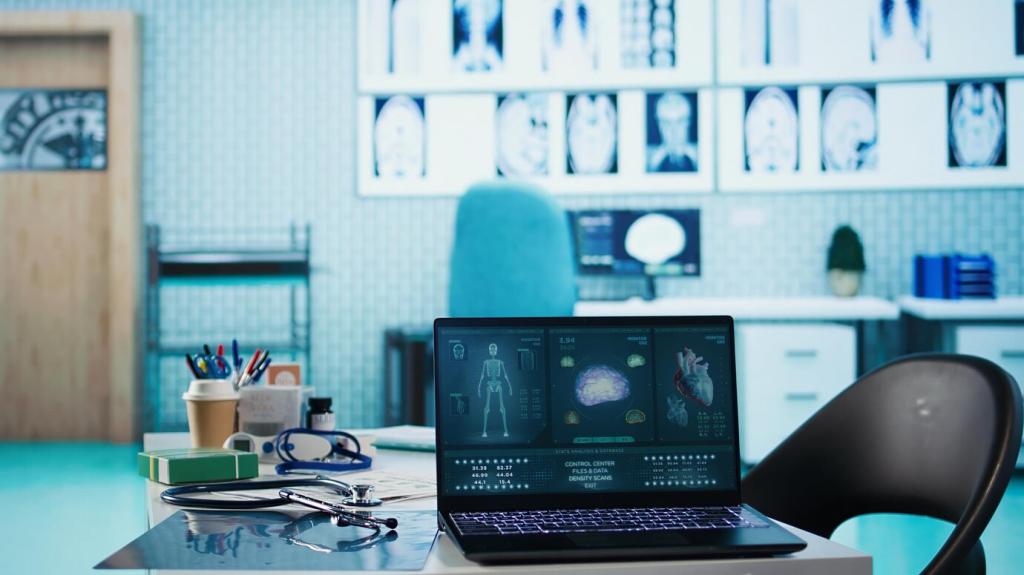AI-Driven Innovations in Medical Diagnosis
The landscape of medical diagnosis is undergoing a remarkable transformation, thanks to the rapid advancements in artificial intelligence. By merging the analytical power of machine learning with the expertise of healthcare professionals, AI is redefining how diseases are detected, quantified, and understood. This new era promises earlier interventions, improved precision, and a reimagined patient experience, ultimately paving the way for more effective and efficient healthcare delivery.
Enhanced Imaging Analysis
Harnessing the power of deep learning, AI algorithms now scrutinize medical images such as X-rays, MRIs, and CT scans with astonishing detail. These computational systems learn from millions of sample images, empowering them to discern subtle abnormalities that even seasoned radiologists might miss. This capability drastically reduces errors and improves the speed at which critical conditions—like tumors or fractures—are detected, streamlining workflows and supporting more rapid clinical decision-making.
Automated Screening Protocols
With AI-driven tools, routine screenings receive a significant upgrade. Algorithms can automatically evaluate data from diagnostic tests, flagging patients at risk for further analysis. This automation not only ensures higher throughput in medical settings but also minimizes the rate of false positives and negatives. As a result, healthcare providers can focus resources on patients who need them the most, ultimately leading to higher quality care and better health outcomes.
Early Detection of Chronic Diseases
AI excels at identifying subtle, early indicators of chronic diseases that might otherwise remain undiagnosed until symptoms become severe. By analyzing a patient’s medical history, genetic data, and lifestyle factors in unison, machine learning models can predict the likelihood of diseases like diabetes or cardiovascular disorders. Such early detection empowers both patients and clinicians to take proactive measures, potentially slowing or even preventing disease progression entirely.
Personalizing Patient Diagnostics
Individualized Risk Assessment
AI algorithms analyze a vast array of data points specific to each patient, including genetic markers, family history, and known risk factors. By processing this information, machine learning models provide a personalized assessment of disease risk that is far more nuanced than traditional methods. This level of granularity enables clinicians and patients to take targeted preventive measures, reducing the likelihood of adverse outcomes and promoting overall wellbeing.

Revolutionizing Pathology and Lab Analysis
Deep learning algorithms are making waves in the field of histopathology, where tissue samples are analyzed for signs of disease. By training on millions of annotated images, AI systems can identify cancerous cells with remarkable accuracy, often matching or exceeding human expertise. This automation dramatically reduces the time required for diagnosis and ensures greater reproducibility, alleviating workload pressures on pathologists and improving outcomes for patients.
The interpretation of genetic data is enormously complex and data-intensive, yet crucial for diagnosing hereditary and rare diseases. AI tools can sift through massive genomic datasets to spot pathogenic mutations and uncover previously hidden patterns. By doing so, they accelerate the identification of genetic disorders, opening the door to earlier interventions and, potentially, new avenues for treatment tailored to the patient’s genetic blueprint.
AI-powered software integrates seamlessly into laboratory information systems, automating data logging, sample organization, and preliminary result evaluations. These enhancements speed up the progression from sample receipt to result delivery, reduce clerical errors, and improve communication between laboratory scientists and clinicians. The result is a more efficient laboratory ecosystem, where diagnoses are rendered faster and patients receive timely care.

Integrating Wearables and Remote Monitoring
Wearable devices, such as smartwatches and biosensors, generate a wealth of physiological data on heart rate, sleep patterns, glucose levels, and more. AI algorithms process this continuous stream, detecting anomalies that might signal the onset of disease or deteriorating health. By catching warning signs early, healthcare providers can reach out proactively, often before the patient perceives symptoms, facilitating more timely and effective interventions.
Augmented Clinician Decision-Making
Even the most diligent clinicians can benefit from additional analytical support. AI-powered diagnostic aids provide cross-validation of findings, offering potential diagnoses that clinicians might not have initially considered. These tools access vast libraries of medical knowledge and pattern recognition, enhancing confidence in final decisions and reducing missed or incorrect diagnoses.
Cross-Referencing Patient Histories
Medical misdiagnoses often result from incomplete information. AI systems cross-reference current symptoms against comprehensive databases of patient histories, noting patterns and red flags the human eye may overlook. By contextualizing new data within a patient’s ongoing medical journey, AI ensures that historical warning signs and trends inform each new diagnostic event, thus minimizing oversights.
Continual Learning from Outcomes
Modern AI systems learn not only from established datasets but also from ongoing clinical outcomes. Every new diagnosis and its result feeds back into the AI model, refining its accuracy over time. This continual learning loop ensures that diagnostic systems adapt to emerging diseases, novel presentations, and variations across patient populations, supporting a dynamic and ever-improving standard of care.
Previous slide
Next slide
Overcoming Challenges and Addressing Bias

Medical data is deeply personal, and its protection is of utmost importance. AI systems must be built on robust frameworks that encrypt, anonymize, and safeguard patient information against misuse or unauthorized access. Institutions need to uphold strict data governance protocols to maintain patient trust and comply with regulatory requirements, ensuring that technological progress does not come at the expense of privacy.
